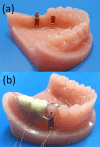Biomechanics of different thread designs of dental implants assisting unilateral free end mandibular partial dentures
- PMID: 40437488
- PMCID: PMC12117796
- DOI: 10.1186/s12903-025-06255-0
Biomechanics of different thread designs of dental implants assisting unilateral free end mandibular partial dentures
Abstract
Background: Dental implants assisting unilateral free end mandibular partial dentures (RPDs) improve their performance and prognosis, however, no consensus exists on the type of thread used in these implants. The current work studied the effect of dental implant thread design on stress distribution around dental implants assisting unilateral free end RPDs using strain gauges and finite element analysis to select the best performing thread design.
Methods: Twenty-four custom made titanium-aluminum-vanadium (Ti-6Al-4 V) implants were designed and milled 4 thread designs; V-shaped, buttress, reverse-buttress and trapezoid, and were inserted in the approximate locations of tooth number 36 in 6 polymethyl methacrylate Class II Kennedy models, which had teeth number 36, 37, and 38 missing, and unilateral removable partial dentures were constructed to fit each model, with a metal housings and O-rings in their fitting surface attaching to the ball abutment. Surface strains were measured with strain gauges, and mean stresses around the implants, and principal abutments in each tested model were compared using one way analysis of variance (ANOVA). The finite element analysis, recorded stresses, around each dental implant thread design, in the form of colorcoded maps using Von Mises stress analysis.
Results: The recorded micro-strains around V-shaped threads and their related abutments were higher than those recorded around the buttress threads and their related abutments, reverse buttress threads and their related abutments, and trapezoid threads and their related abutments in descending order as determined by one‑way ANOVA (F = 284.489, p < 0.001), and Tukey post hoc pairwise comparison (p < 0.001). FEA results presented the stresses generated around each thread design, under vertical load, the highest stress concentration values were observed around V-shaped threads, followed by the buttress threads, the reverse buttress threads, and finally the least stresses were observed around the trapezoid threads. Under oblique load, more stresses were observed than those under vertical load, being also greatest around V-shaped threads, then decreasing around buttress, reverse buttress, and trapezoid threads.
Conclusions: The strain gauge and finite element analysis revealed that the trapezoid threads demonstrated least stress concentration at the bone implant interface, followed by the reverse buttress, buttress, and finally the V-shaped threads.
Keywords: Dental implant; Finite element analysis; Strain gauges; Thread design; Titanium.
© 2025. The Author(s).
Conflict of interest statement
Declarations. Ethics approval and consent to participate: Not applicable. Consent for publication: Not applicable. Competing interests: The authors declare no competing interests.
Figures








Similar articles
-
[Influence of thread shapes of custommade root-analogue implants on stress distribution of peri-implant bone: A three-dimensional finite element analysis].Beijing Da Xue Xue Bao Yi Xue Ban. 2019 Dec 18;51(6):1130-1137. doi: 10.19723/j.issn.1671-167X.2019.06.027. Beijing Da Xue Xue Bao Yi Xue Ban. 2019. PMID: 31848517 Free PMC article. Chinese.
-
Comparison of finite element results with photoelastic stress analysis around dental implants with different threads.Dent Med Probl. 2018 Jan-Mar;55(1):17-22. doi: 10.17219/dmp/85077. Dent Med Probl. 2018. PMID: 30152630
-
Finite element analysis of stress distribution in unilateral distal extension partial dentures: a comparison of four attachment designs.BMC Oral Health. 2025 May 27;25(1):810. doi: 10.1186/s12903-025-06213-w. BMC Oral Health. 2025. PMID: 40426183 Free PMC article.
-
Biomechanical effects of two different collar implant structures on stress distribution under cantilever fixed partial dentures.Acta Odontol Scand. 2011 Nov;69(6):374-84. doi: 10.3109/00016357.2011.572287. Epub 2011 Mar 30. Acta Odontol Scand. 2011. PMID: 21449688
-
Biomechanics in Removable Partial Dentures: A Literature Review of FEA-Based Studies.Biomed Res Int. 2021 Aug 26;2021:5699962. doi: 10.1155/2021/5699962. eCollection 2021. Biomed Res Int. 2021. PMID: 34485518 Free PMC article. Review.
References
-
- Murakami K, Ayukawa Y, Ogino Y, Nakagawa A, Horikawa T, Yamaguchi E, Takaki K, Koyano K. Clinical effectiveness of implant support for distal extension removable partial dentures: functional evaluation using occlusal force measurement and masticatory efficiency. Int J Implant Dentistry. 2021;7:1–7. - PMC - PubMed
-
- Alkhodary MA. Class II Kennedy implant assisted mandibular removable partial dentures with and without cross arch stabilization: A strain gauge in vitro study. Egypt Dent J. 2020;66(2):1173–82.
-
- ELsyad MA, El Ghany Kabil AA, El Mekawy N. Effect of implant position and edentulous span length on stresses around implants assisting claspless distal extension partial overdentures: an in vitro study. J Oral Implantology. 2017;43(2):100–6. - PubMed
MeSH terms
Substances
LinkOut - more resources
Full Text Sources

